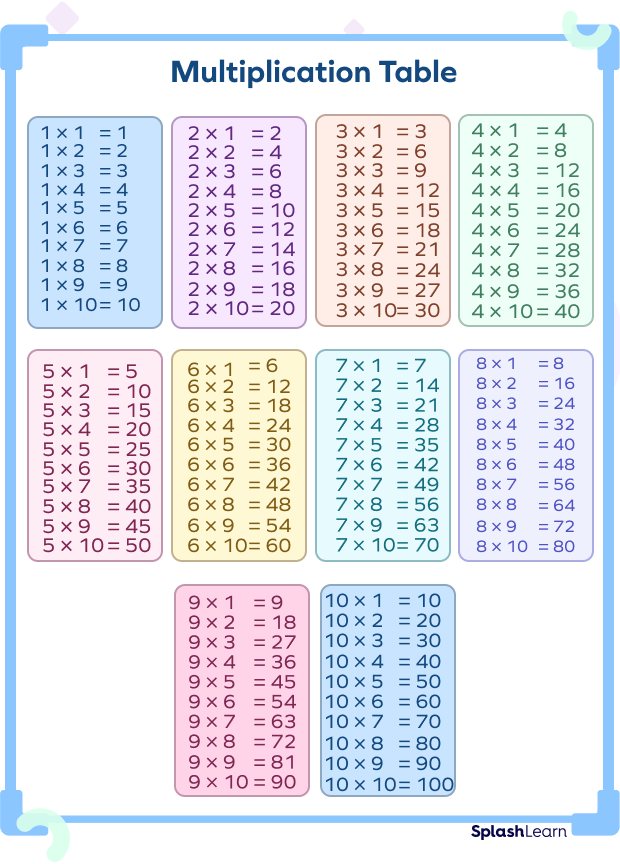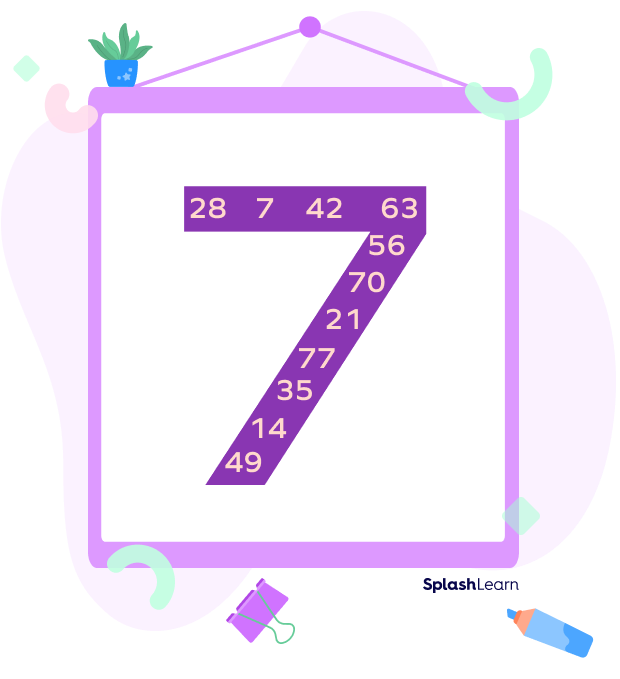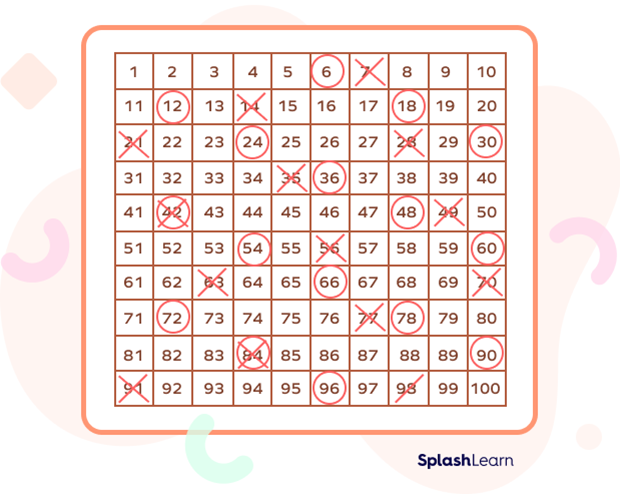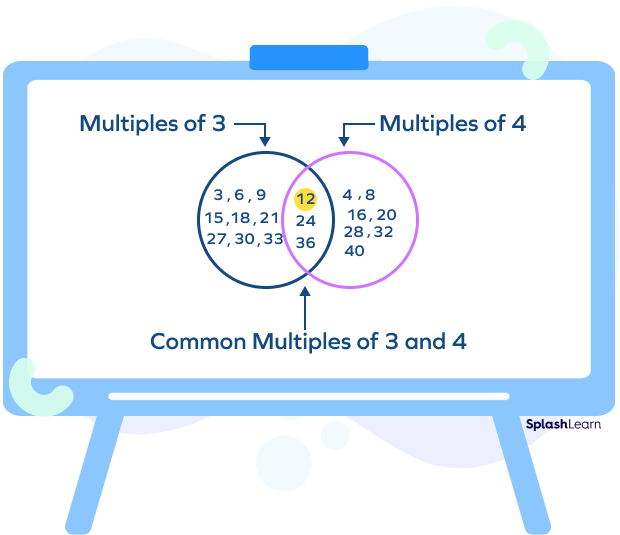What Are Multiples Of 7

We all know multiplication tables equally we always employ them to solve math problems. And, when we utilise these tables, we are also using multiples. You encounter, when we multiply two numbers, the answer is their multiple.
What are Multiples?
Multiplying a number by counting numbers gives u.s.a. its multiples. In math, the meaning of a multiple is the product or outcome of one number multiplied by some other number.
Let us attempt and understand this concept using a few examples. It is quite elementary. Nosotros can get the multiples of half-dozen and vii past multiplying them by numbers 1, two, three, …, and so on.
The multiples of 6 are: half-dozen, 12, 18, 24, 30, 36, 42, 48, 54, 60, …

For instance, let u.s.a. take 5 × 6 = xxx. Here thirty is a multiple of both 5 and six.
Let us attempt another instance.
The multiples of 7 are: vii, 14, 21, 28, 35, 42, 49, 56, 63, seventy, …

So, what numbers would yous multiply to get xiv? You will employ 2 and 7.
For 2 × seven, the answer is the number 14. So, 14 here is a multiple of 2 and seven.
Properties of Multiples
- The number of multiples of any given number is infinite.
- Every number is a multiple of itself.
- The multiple of a number is greater than or equal to the number itself (except for 0).
You have a lot in common with your friends, don't you? Now, numbers, too, sometimes take things in mutual. One of these things is multiples. When that happens, we say that the numbers accept common multiples. And that is the topic nosotros are going to focus on. So, let us swoop in.
What are Common Multiples?
A mutual multiple is defined as a whole number, a shared multiple of each set of numbers. The multiples common to two or more than numbers are called the common multiples of those numbers.
Let us mark the multiples of 6 and 7 on a hundred filigree. We will marker the multiples of vi by a circle and multiples of 7 past a cross.

The numbers that are circled besides as crossed are the common multiples of 6 and vii.
Then, the common multiples of half-dozen and seven are 42 and 84.
We can find the common multiples of two or more numbers by listing the multiples of each number.
What is a Least Common Multiple?
The smallest common multiple of two or more numbers is called the Least Common Multiple (LCM).
For instance, to find the common multiples of 3 and 4, we list their multiples and and then discover their mutual multiples.
The multiples of iii are: 3, 6, nine, 12, 15, xviii, 21, 24, 27, xxx, 33, 36, …
The multiples of 4 are: 4, viii, 12, 16, 20, 24, 28, 32, 36, twoscore, …
The common multiples of iii and 4 are: 12, 24, 36, ….
The smallest of these is 12. So the LCM of 3 and 4 is 12.

Fun Fact:
- A number can accept an space (unlimited) number of multiples. Therefore, whatever two numbers or set of numbers tin have an infinite number of common multiples.
Solved Examples
Q1. What are the multiples of the number ix?
Solution:
Nosotros know that we can get multiples of a number past multiplying it by 1, 2, 3, …, and and so on. Then, the multiples of 9 are : nine, xviii, 27, 36, 45, 54, 63, 72, 81, xc, …
Q2. Discover ii common multiples of the numbers ii and 10.
Solution:
Nosotros know that the multiples common to ii or more numbers are called the mutual multiples of those numbers.
Now, the multiples of 2 are: 2, 4, 6, 8, 10, 12, 14, 16, 18, twenty, … and the multiples of 10 are: 10 , 20 , 30, forty, 50, sixty, lxx, eighty, ninety, 100, …
So, the two mutual multiples of 2 and 10 are 10 and 20.
Q3. Notice the LCM of 3 and 5.
Solution:
The smallest common multiple of 2 or more numbers is called the To the lowest degree Common Multiple (LCM). The multiples of 3 are: iii, half dozen, 9, 12, 15 , eighteen, 21, 24, 27, 30, …
The multiples of 5 are: 5, x, 15, 20, 25, 30 , 35, forty, 45, 50, … The mutual multiples of 3 and five are: 15, xxx, …
The smallest of these is 15. So the LCM of three and 5 is 15.
Practice Bug
Common Multiples - Definition with Examples
Attend this Quiz & Exam your knowledge.
16
28
64
88
Correct answer is: 28
The multiples of 8 are: 8, sixteen, 24, 32, 40, …
So, 28 is not a multiple of 8.
16
20
forty
lxxx
Correct answer is: 80
Now,the multiples of 16 are$\colon$16,32,48,64,$\underline{eighty}$,96,112,128,144,$\underline{160}\dots$
and the multiples of 20 are$\colon$twenty,40,$\underline{sixty}$,eighty,100,120,140,$\underline{160}$,180,200$\dots$
And then,the common multiples of 16 and 20 are$\colon$80 and 160,of which fourscore is option d.
30
60
120
180
Correct answer is: 30
30 is a multiple of 15, but not of 12. And so, xxx is not a common multiple of 12 and 15.
19
18
27
36
Right answer is: 18
18 is the smallest mutual multiple of 9 and 18. And so, xviii is the LCM of nine and 18.
Frequently Asked Questions
What are the multiples of the number nil?
The multiples of zero is zero. Every other whole number has infinitely many multiples.
For example: 25 × 0 = 0 ; i.0836 × 0 = 0 ; -9/87 × 0 = 0.
What are the multiples of the number one?
All the natural numbers are multiples of 1. At that place is no end to multiples of whatsoever number. The kickoff ten multiples of the number 1 starting from ane are 1, 2, 3, 4, 5, 6, seven, 8, 9, and 10.
What is the LCM of prime number numbers?
The brusk course LCM stands for Least Mutual Multiple. The smallest common multiple of two or more prime numbers is their production.
For case: The LCM of 3 and 7 is 21.
What Are Multiples Of 7,
Source: https://www.splashlearn.com/math-vocabulary/fractions/common-multiple
Posted by: millermrsawas.blogspot.com


0 Response to "What Are Multiples Of 7"
Post a Comment